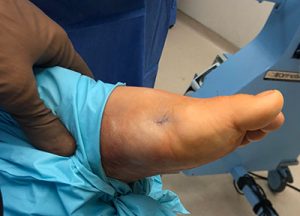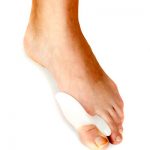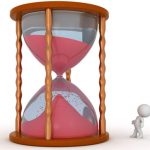A lot of bunion sufferers come to us stating that they avoided bunion surgery for years because they “heard” terrible things that are simply untrue about bunion surgery. Two examples of this are “bunion surgery hurts like crazy” and “why bother getting a bunion surgically repaired since they come back anyway.”
There are many bunion surgery myths and we are here today to put an end to them!
What is a fact is our patients always say after surgery “why did I wait so long and suffer so much?”
As you may know, a bunion is a structural problem which causes either the big toe joint to shift toward the other toes, thus causing a boney prominence. Sometime the baby toe does the same thing, it’s called a “tailors bunion.” And some particularly unlucky people have both types of bunions.
Surgery’s performed to permanently correct the problem. But since we are believers that one should try to avoid surgery with more conservative measures when possible, we think bunion surgery is a final measure.
When a bunion becomes painful or gets in the way of your quality of a life, it’s usually (though not always) the time there’s no other option.
So, for those considering bunion surgery, we present you 16 bunion surgery myth busters for your reading pleasure. See our bunion surgery before and after pictures whenever you want. Enjoy!
Bunion Surgery Myth #1: Bunion surgery is very painful.
While pain following surgery can’t be avoided altogether, the doctors at UFAI work hard to make the recovery period as comfortable as possible. A lot of this depends on the skill of your surgeon.
Nerve blocks during surgery help with the immediate post-surgical pain and through our extensive experience performing bunion surgeries and managing pain.
At UFAI we have been able to make our bunion surgeries virtually painless. We concentrate on a variety things to control pain, including:
- Expert surgical skill and care. We don’t “hack away” at the tissue.
- Stable fixation so the bones don’t move, resulting in less swelling and pain.
- Long acting local anesthesia and a proprietary mix of cocktail that controls swelling and pain.
- The boot we use allows for stability and less movement with less pain.
- We use anti inflammation protocols after surgery that reduce pain and swelling without the need for major narcotic use.
The following five star Yelp review was posted by University Foot and Ankle Institute bunion patient, Shabnam and talks about how little pain they experienced after bunion surgery:
…From start to finish, before and after my bunion surgery, [my Dr.] and his staff took great care of me.
The surgery was fast and precise, with clean incisions and nearly painless recovery. I did not need to take any of my pain medication.
Everyone in his office is warm, friendly and knowledgeable, which makes the entire experience very smooth and pleasant
Bunion Surgery Myth #2: I won’t be able to return to my favorite activities and playing sports after surgery.
Bunion surgery always carries some temporary restrictions during the healing period. 
While we can’t promise a better golf score, we can get rid of the bunion and reduce your pain while playing.
Bunion Surgery Myth #3: All bunion procedures are the same.
Nope, not true at all! Because bunions come in all shapes and sizes, there is actually a nice variety of surgical approaches to correcting bunions. There is not a uniform, cookie cutter approach to successful bunion correction.
At UFAI we’re expertly trained on all different types of bunion surgeries and focus on choosing the right procedure for your foot and you as an individual.
We look at many factors: the toe position, the foot structure, length of the bone, position of the first metatarsal, adjacent toes, presence of any arthritis, lifestyle, desired activities and footwear, medications, medical conditions, etc.
There is a lot to factor in to the right choice for the right patient. Bunion procedures are very different and a good outcome requires proper procedure selection.
Bunion Surgery Myth #4: I won’t be able to wear high heels or some other shoes after bunion surgery.
One of the main complaints with bunions is that shoes don’t fit properly and cause pain, especially high heels. So, bunion surgery is often considered due to shoe irritation and pain while in shoes.
The surgery’ designed to reduce the prominent bone and thereby help the foot fit in shoes better. So, in the majority of cases, after bunion surgery you’ll be much more comfortable in your shoes. There are usually no specific shoe restrictions following bunion surgery, in fact, fitting in shoes better is one of the benefits of undergoing correction of bunion deformities.
Bunion Surgery Myth #5: Recovery is long and I could be off work for weeks following bunion surgery
Recovery after bunion surgery varies based on the procedure performed. In most cases, UFAI recommends a period of 3-5 days with minimal activity, keeping the foot elevated and icing periodically.
Once you get past that initial 3-5 days, it is usually okay to get up and move around more. Elevating and icing is still helpful, but many people can get back to work shortly thereafter.
If your job is physically demanding and there are not light-duty options following surgery, then a period of disability and time off work can be considered.
We can usually get you back into some semblance of a normal shoe by 4-6 weeks following surgery. UFAI approaches surgery with the mindset of performing strong correction and fixation that allows early range of motion and earlier weight bearing.
Bunion Surgery Myth #6: I’ll have unsightly scars after surgery.

Tiny surgical incision immediately following our MinVasive Bunionectomy™
Part of our challenge as surgeons of the foot and ankle is to try and minimize scarring. UFAI uses measures to help reduce the chances for significant scarring, including minimizing operating time, minimizing post-operative swelling, using proven stitch techniques and small stitch material, and placing scars in inconspicuous places where possible.
In many cases, bunion incisions can be hidden on the inside of the foot so it’s not visible from the top view. Unless you are prone to keloids (thick, raised scars), you should anticipate a nice, flat, small scar from your bunion surgery.
If you are prone to keloids, strategies are used in surgery and following surgery to help minimize scarring.
UFAI understands that leaving faint superficial scars are an important part of a successful bunion correction. It’s important to remember that scars usually fade slowly and gradually following surgery.
Bunion Surgery Myth #7: The only reason to correct a bunion is if it’s painful.
Pain is the primary indicator for bunion surgery, but it’s not quite that simple. While we generally discourage surgery if you are not in pain, bunions can progress to cause significant arthritis and other complications.
Bunions are a complex deformity that must be evaluated with a thoughtful approach, looking at the whole foot and not just the large bump.
If left untreated, bunions can lead to the following: big toe joint arthritis, hammertoe deformity, ligament tears, tendinitis, and the list goes on. So, the reasons to consider bunion surgery do include pain and discomfort, but we also consider surgery to help AVOID the complicating factors listed here. Surgery does become more involved and more difficult if you wait until it is a severe deformity. Sometimes, early pain and discomfort is a reason to consider surgery to help avoid a more invasive and involved surgery.
Bunion Surgery Myth #8: I can use a bunion splint to slowly correct my bunion.

Other conservative treatments like padding, shoe changes, orthotics, injections, all can help live around the bunion and try to make it more comfortable. Surgery, however, is the only way to actually correct the deformity.
Bunion Surgery Myth #9: Can’t you just shave off the bump?
Bunions are actually rarely just an overgrowth of bone. In the strong majority of cases, there is misalignment of the bone (first metatarsal) that makes it stick out and become prominent. Therefore, just shaving the bump helps some, but comes with a high rate of recurrence.
Shaving the bunion bump can be an effective treatment for an older individual with a mild bunion deformity. But is rarely the right choice for most bunions.
Bunion Surgery Myth #10: All bunions will eventually require surgery.
Not true! Bunions come in all shapes and sizes. Mild bunions, when caught early and managed appropriately, might slow down and symptoms can lessen. In general, if you want to avoid surgery, as early as possible: wear good shoes, use custom orthotics, try bunion splints, and keep your fingers crossed.
Bunion Surgery Myth #11: If I have surgery on one foot, I must do the other foot.
It’s actually rare for the right and left foot to match perfectly. It’s possible that you may need surgery to correct a bunion on one foot, and that you won’t need it on the other. It’s also possible that a bunion may continue to develop and you’ll need it in the future. Using the strategies mentioned in MYTH above can help slow down the worsening of bunions and could help you avoid it on the other foot.
Bunion Surgery Myth #12: Bunion surgery takes hours.
Bunion surgery does vary in its complexity, but as a general rule, most bunion surgeries can be completed in less than an hour. While surgery should not be hurried, an important part of good and successful surgery is an efficient and timely procedure. Surgeons at UFAI focus on performing efficient and successful bunion surgeries. Shorter surgeries usually lead to less pain, less swelling, quicker healing, less scarring and stiffness after surgery, and help to minimize risks with anesthesia.
Bunion Surgery Myth #13: I’ll be in a cast and need crutches after bunion surgery.
The most common bunion procedures performed do not require a cast and crutches following surgery. Recovery usually includes temporary protection and immobilization in a walking boot, that allows partial or full weight bearing on the surgically-repaired foot.
Cast and crutches are sometimes used for more severe bunion deformities. UFAI’s dedicated to helping you through the process. Today there’s some great crutch alternatives like the I-Walk or a knee scooter like the JusGo scooter.
Bunion Surgery Myth #14: Bunions often return after surgery.
If the correct procedure is chosen for the specific bunion, and the surgery is performed well, recurrence should not happen.UFAI prefers to perform a good and proper surgery and fix it right the first time. While recurrence is a risk following bunion surgery, the surgeons at UFAI are focused on performing corrective surgery that stands up over time.
Our goal is to fix the bunion right, and fix it once.
Bunion Surgery Myth #15: I’ll set off the metal detectors at the airport after bunion surgery.
Small implanted hardware commonly used in bunion surgery do not set off the metal detectors at the airport. Even if you come across a very sensitive scanner somewhere, just inform them you have screws in your foot and request use of the hand held scanner. It is not required to carry a card or letter certifying the presence of hardware.
Bunion Surgery Myth #16: I’ll need screws/hardware removed after surgery.
In most bunion surgery cases, hardware’s used to fixate the corrected deformity. The screws or pins are flush with the bone to reduce any tissue or tendon irritation. In most cases, people don’t ever feel the screws used. Occasionally, hardware can push out enough it can be uncomfortable.
In these cases, removal of the screws is a simple procedure with a minimal recovery period. Once the bone heals, the area does not need the hardware anymore, so removing the screws, if necessary, does not affect the correction of the bunion.
Why University Foot and Ankle Institute is the best choice for Bunion Surgery in California?
The doctors at UFAI are thoroughly trained and highly skilled in all the effective ways to correct bunions.
If you’re experiencing problems with bunions or with your feet in any way, we’re here to help. Our nationally recognized foot and ankle specialists offer the most advanced podiatric care with the highest success rates in the nation. We are leaders in the research and treatment of all foot and ankle conditions.
For more information or to schedule a consultation, please call (877) 736-6001 or visit us here to make an appointment online.
- Revolutionizing Extremity Imaging: UFAI’s Open MRI for the Foot and Ankle - October 21, 2023
- Youth Sports and Heel Pain: Should Kids Play with Pain? - April 4, 2023
- All About Foot Arch Pain and Foot Arch Cramps - March 15, 2021


